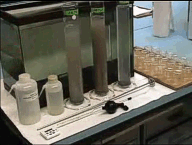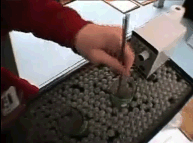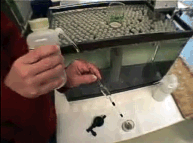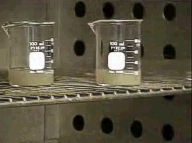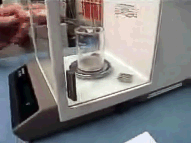|
|
|
|
VIDEO FRAME
|
NARRATIVE
|
|
|
The most commonly performed
sedimentation-based procedure for the analysis of the fine fraction
of sediments is the pipette method. This method, which is based on
Stoke’s Law, requires that the analyst has removed the coarse
fraction from the sample, that the fine fraction is about 15 grams,
that the suspension remains at a constant temperature and contains a
known amount of dispersant (usually 0.5% sodium hexametaphosphate),
and that the volume of the suspension is exactly 1000 ml. |
|
|
To start the procedure, vigorously stir the
suspension. Begin at the bottom with short rapid strokes, working up
the cylinder with progressively longer strokes until all of the
sediment is evenly distributed. When stirring is complete, start the
timer. |
|
|
After 20 seconds, insert the
pipette to a depth of 20 cm and withdraw exactly 20 ml. |
|
|
Empty the pipette into a pre-weighed beaker, |
|
|
and rinse the pipette with a
small amount of distilled water. Continue withdrawals at the
specified depth and time intervals. If more than one sample is to be
analyzed at a time, care must be taken to ensure that no withdrawal
times, or the procedures to be performed at those times, overlap. |
|
|
The solid content of each withdrawal is
determined by evaporation or oven drying |
|
|
and weighing, with corrections
for the dissolved dispersant and salts. |

